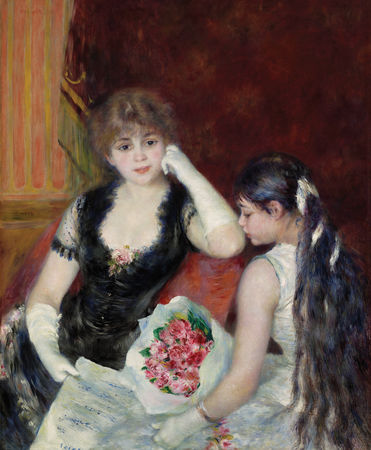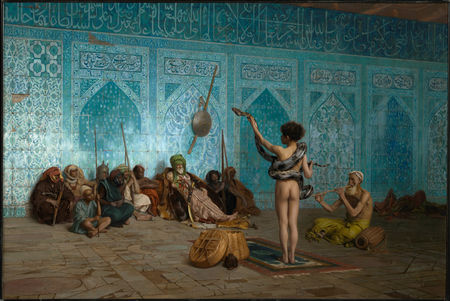"The Age of Impressionism: Great French Paintings from the Clark" @ Kimbell Art Museum
Pierre-Auguste Renoir (1841–1919). Venice, the Doge's Palace, 1881. Oil on canvas, 21 1/2 x 25 7/8 in. (54.5 x 65.7 cm). Acquired by Sterling and Francine Clark, 1933
FORT WORTH, TX.- On March 11, 2012, The Age of Impressionism: Great French Paintings from the Clark opened at the Kimbell Art Museum, the only U.S. venue for this first-‐ever international touring exhibition of French Impressionist masterpieces from the Sterling and Francine Clark Art Institute in Williamstown, Massachusetts. The Clark’s superb collection of French Impressionist paintings, which features a remarkable group of works by Pierre-‐Auguste Renoir, is renowned throughout the world. The Clark exhibition is touring for a period of three years (2011–14) and appears at major venues in Italy, France, Spain, the United Kingdom, Canada, Japan, and China.
“We are honored to showcase this extraordinary collection,” commented Eric M. Lee, director of the Kimbell Art Museum. “Because many of the Impressionists painted outdoors, their works will sing out especially vibrantly in the natural light of Louis Kahn’s renowned gallery spaces. Visitors to the Museum are in for a stunning encounter with beautiful art enhanced by iconic architecture.”
Berthe Morisot (1841–1895), The Bath, 1885–86. Oil on canvas, 36 1/4 x 28 7/8 in. (92.1 x 73.3 cm). Acquired by Sterling and Francine Clark, 1949
The Kimbell has a long tradition of hosting some of the most esteemed Impressionist collections from around the world, which began with its very first special exhibition, Impressionist and Post-‐Impressionist Paintings from the U.S.S.R (1973), drawn from the State Hermitage Museum in St. Petersburg and the State Pushkin Museum of Fine Arts in Moscow, and continued with exhibitions of works from the Courtauld Institute, London (1987); the Barnes Foundation, Merion, Penn. (1994); the Musée de l’Orangerie, Paris (2000–1); and the Art Institute of Chicago (2008).
The selection of 72 paintings in The Age of Impressionism includes 21 by Renoir, six by Claude Monet, seven by Camille Pissarro, four by Alfred Sisley, three by Edgar Degas, two by Edouard Manet, and two by Berthe Morisot. Many are celebrated masterpieces of Impressionism that visitors will recognize from reproductions even if they have never been to Williamstown to see them in person. The exhibition also features examples of the work of some leading French artists of the period who worked in alternative styles, including the landscape painters Camille Corot and Théodore Rousseau, figure painters William-‐Adolphe Bouguereau, Jean-‐Léon Gérôme, and Jacques-‐Joseph Tissot, and the post-‐Impressionist painters Henri de Toulouse-‐ Lautrec and Paul Gauguin.
Camille Pissarro (1830–1903), The River Oise near Pontoise, 1873. Oil on canvas, 18 1/8 x 21 7/8 in. (46 x 55.7 cm). Acquired by Sterling and Francine Clark, 1945
“The Age of Impressionism offers our visitors a chance to understand more than 70 great works of art through the personality and taste of the two remarkable collectors who founded the Clark Art Institute,” said George T.M. Shackelford, Kimbell deputy director. “Sterling Clark was an heir to the Singer sewing machine fortune, who married in 1919 Francine Clary—a Frenchwoman who had been an actress at the Comédie Française. Together, they assembled for their homes in Paris and New York one of the finest collections of paintings, sculpture, and drawings formed in the early 20th century.”
Although the French Impressionists were the heart of the collection, the Clarks ranged widely in their tastes—paintings by the Old Masters found favor, as well as works by the modern Americans John Singer Sargent and Winslow Homer. The couple founded the Clark Art Institute as a showcase for the collection in 1955. Although the Institute’s holdings have expanded greatly since then, notably through the addition of a growing collection of early photography, its scope and character continue to represent the interests of the founders.
Claude Monet (1840–1926), The Cliffs at Étretat, 1885. Oil on canvas, 25 5/8 x 32 in. (65.1 x 81.3 cm). Acquired by Sterling and Francine Clark, 1933
The Age of Impressionism represents all the important types of painting that the Impressionists practiced, from landscapes to figure compositions and still lifes. Their near-‐magical mastery of effects of natural light comes through strongly in Monet’s springtime view of Tulip Fields at Sassenheim, near Leiden or Pissarro’s Piette’s House at Montfoucault, a winter scene. The Clark Renoirs are virtually an exhibition within the exhibition, representing the range of his subject matter and the evolution of his style from the 1870s to the 1890s. They include some of the most sensuous and seductive of all his works—such unabashed celebrations of youth and beauty as Girl with a Fan and Sleeping Girl. Among the other masterpieces of Impressionist figure painting in the exhibition is one of the most beautiful of Degas’s behind-‐the-‐scenes paintings of the ballet, Dancers in the Classroom, its off-‐centered composition reflecting the artist’s love of Japanese woodblock prints.
Pierre-Auguste Renoir (1841–1919). A Box at the Theater (At the Concert), 1880. Oil on canvas, 39 1/8 x 31 3/4 in. (99.4 x 80.7 cm).. Acquired by Sterling and Francine Clark, 1928
Grouped near the beginning of the exhibition, paintings such as Gérôme’s Fellah Women Drawing Water give a sense of the high level of technical “finish” practiced by older painters and beloved of more conservative taste during the Impressionist era. Again, it is to the credit of Sterling and Francine Clark that they were able to appreciate the work of artists other than their favorites of the Impressionist avant-‐garde. “Academic, yes, tight, yes,” Sterling Clark said of one of his paintings by Gérôme, “but what drawing and mastery of the art.”
Jean-Léon Gérôme, The Snake Charmer, c. 1879, oil on canvas. © Sterling and Francine Clark Art Institute, Williamstown, Mass.
The exhibition concludes by suggesting some of the stylistic paths that the Impressionists opened up for younger painters. Gauguin’s Young Christian Girl, for example, shows Impressionist technique and color deployed in a less purely descriptive, more personal and stylized manner.
William-Adolphe Bouguereau, Seated Nude, 1884, oil on canvas. © Sterling and Francine Clark Art Institute, Williamstown, Mass.

/https%3A%2F%2Fprofilepics.canalblog.com%2Fprofilepics%2F1%2F0%2F100183.jpg)
/https%3A%2F%2Fstorage.canalblog.com%2F03%2F02%2F119589%2F96711876_o.jpg)
/https%3A%2F%2Fstorage.canalblog.com%2F11%2F31%2F119589%2F94773502_o.jpg)
/https%3A%2F%2Fstorage.canalblog.com%2F20%2F83%2F119589%2F94772815_o.jpg)
/https%3A%2F%2Fstorage.canalblog.com%2F26%2F72%2F119589%2F75604929_o.jpg)
/https%3A%2F%2Fstorage.canalblog.com%2F59%2F60%2F119589%2F26458628_o.jpg)









/http%3A%2F%2Fstorage.canalblog.com%2F36%2F16%2F119589%2F127992333_o.jpg)
/http%3A%2F%2Fstorage.canalblog.com%2F38%2F42%2F119589%2F127214493_o.jpg)
/http%3A%2F%2Fstorage.canalblog.com%2F26%2F16%2F119589%2F126870661_o.jpg)
/http%3A%2F%2Fstorage.canalblog.com%2F12%2F34%2F119589%2F126853185_o.jpg)